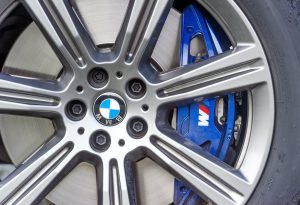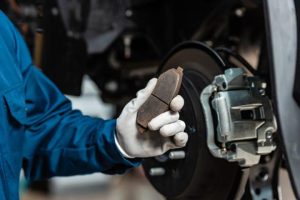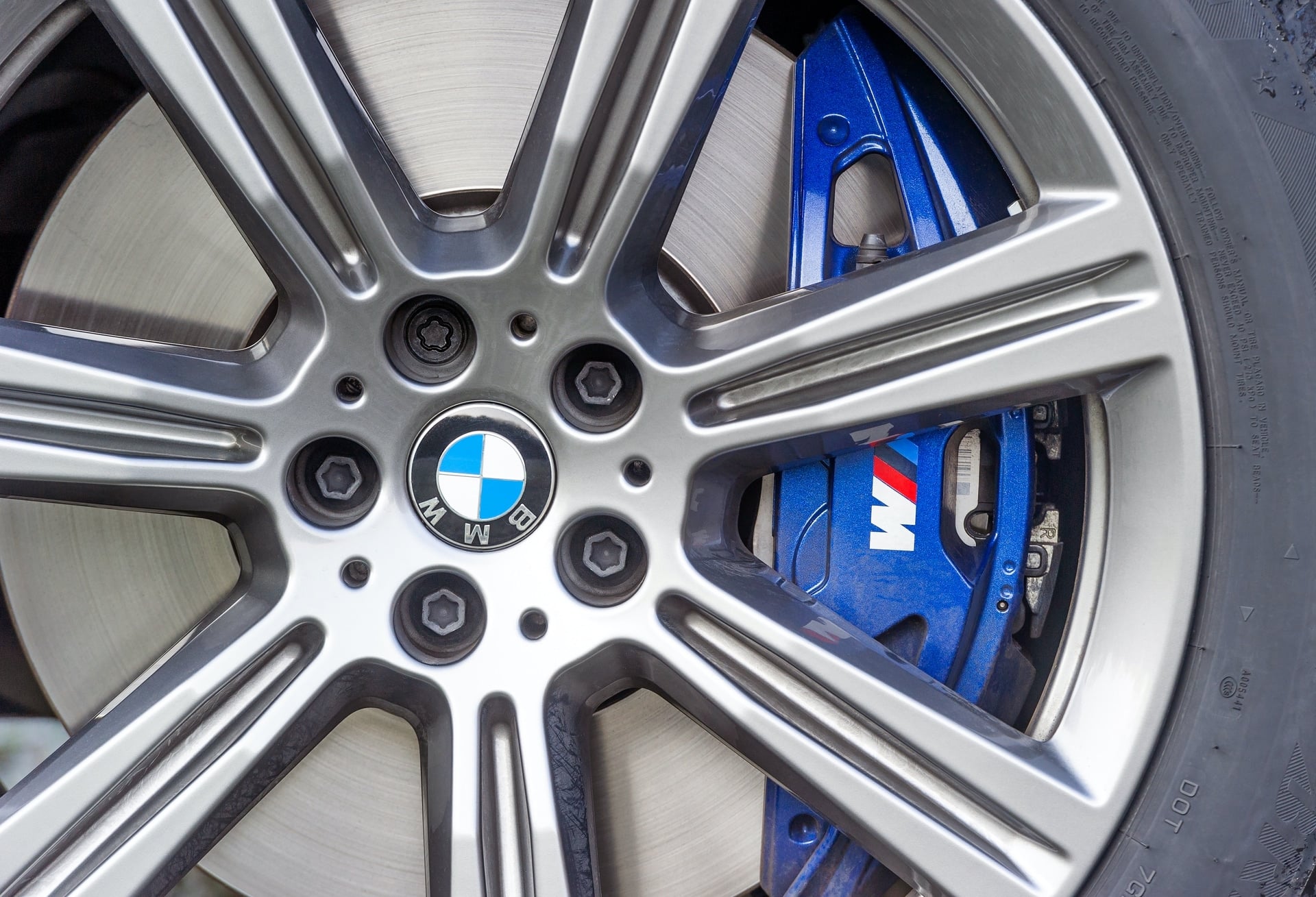BMW Brake Pads
Are you looking to replace the brake pads on your BMW?
Identifying whether you need new ones can be tricky, so, if you think it could be time for new brake pads on your BMW, then this blog post is for you.
Did you know that a quarter of all road accidents happen due to poor braking performance?
We can’t stress enough how important your brakes are to your safety, so don’t ignore any issues or delay any repairs. Our BMW experts here at South Coast Garage are on hand for all your brake system needs. In this blog they share all their knowledge on how to keep your BMW brakes in top condition.
So let’s get straight into it, shall we?

BMW Brake Pads – All You Need to Know
Brake pads are a fundamental component of a vehicle’s braking system, responsible for slowing down or stopping the vehicle when you press the brake pedal. Here’s how they work:
- Creating Friction: When you press the brake pedal, hydraulic pressure is applied to the brake calliper through the brake fluid, causing it to squeeze the brake pads against the brake disc, creating friction.
- Slowing Down or Stopping: The friction between the brake pads and the discs creates a resisting force that slows down the rotation of the wheels, slowing the vehicle and eventually bringing it to a complete stop, if the braking force is sufficient.
- Heat Dissipation: The friction caused during this process creates significant heat in the brakes. However, brake systems are designed to handle and dissipate this heat to prevent brake fade (a decrease in braking performance due to excessive heat). The brake disc is designed with cooling fins or ventilation holes to help disperse heat, preventing the brake components from becoming too hot.
- Release of Brake Pressure: When you release the brake pedal, the hydraulic pressure in the brake system decreases, allowing the brake pads to move away from the discs, so the vehicle can move freely.
Brake pads are subject to wear and tear due to the constant friction and heat generated during braking. Over time, they become thinner and less effective, necessitating replacement to maintain safe braking performance. BMW provides guidelines for brake pad replacement intervals, but it’s important to monitor your brakes’ condition and have them inspected regularly, by a trusted BMW garage like us here at South Coast Garage, to ensure your vehicle’s braking system remains reliable and safe.
At South Coast Garage, our BMW specialists have decades of experience working on all kinds of BMW models. Our expert technicians will keep your brakes working like new regardless of whether you own an M4, X5, 1 Series or another model of these luxury cars.
We are your local German vehicle experts in Eastbourne and the surrounding areas, so trust us to fix any BMW brake system issue.
The Signs That Your BMW Brake Pads Need to Be Replaced
Have you been wondering if your BMW’s brake pads need to be replaced? Here are a few signs to watch out for:
- Squealing or squeaking sounds: If you hear unexpected noises while braking, it may mean that your brake pads are worn out.
- Longer stopping distances: As a result of worn brake pads, your BMW’s braking efficiency is reduced, resulting in an increase in stopping distance. This can result in your safety, and the safety of other road users, being compromised.
- Vibrating brake pedal: Feeling vibrations when you step on the brakes? It can indicate uneven wear on the brake pads or rotors. The steering wheel may also vibrate if your BMW has this issue.
- Dashboard warning light: Several newer BMW models come with built-in sensors for detecting brake pad wear. If the pads need to be replaced, a warning light appears on the dashboard.
- Visual check of the braking system: When the brake pads are worn down to a thickness of 3 mm or less, it’s time to replace them. You should be able to see this from visually inspecting the braking system. However, you should always seek professional advice if you do not have experience with this.
Have you noticed any of these signs? Takeaction now. For a quality inspection and replacement, call South Coast Garage today.

What Are the Different Types of BMW Brake Pads?
There are three types of brake pads available for BMWs: organic, semi-metallic, and ceramic.
- Organic pads are softer and quieter, but wear out quicker.
- Semi-metallic pads enhance heat dissipation and performance, but they can be noisier in operation.
- Ceramic pads are usually more costly but provide excellent performance with minimal noise and dust.
You can rely on our expert technicians at South Coast Garage to recommend and install high-quality brake discs that suit your BMW and your budget.
Step-By-Step Instructions for Replacing BMW Brake Pads
Replacing brake pads is a job for a skilled technician. Brake maintenance is essential for safety, so it’s a task that needs completing safely and efficiently.
These are the steps our technicians follow during the process:
- Safety First: The BMW is parked on a flat surface, with the hand brake on.
- Preparation: The wheel nuts on the wheels are loosened, but not completely removed, on the side that the brake pads need changing.
- Car Lifted: The side of the car where the brake pads need changing is lifted, with the jack stands placed securely under the car.
- Wheel Removed: The wheel nuts are now completely removed so the wheel can be taken off in order to access the brakes.
- Brake Calliper Accessed: The brake calliper is located, which is typically held in place by two bolts. These bolts are removed.
- Old Brake Pads Removed: The old brake pads are removed from the calliper bracket.
- Calliper Piston Pushed Back: The calliper piston is pushed back to make room for the new, thicker brake pads.
- New Brake Pads Installed: The new brake pads are inserted into the calliper bracket, aligning them as they were on the old ones.
- Calliper Reattached: The calliper is put back over the new brake pads and secured with the bolts.
- Wheel Replaced: The wheel is put back on and the wheel nuts are tightened, but not fully.
- Car Lowered: The car is carefully lowered off the jack stands, onto the ground.
- Wheel Nuts Tightened: Once the car is on the ground, the wheel nuts are securely tightened.
- Brakes Tested: Before driving, the brake pedal is pressed several times to ensure that the brake pads are properly seated.
- Brake Fluid Level Checked: The brake fluid level will be checked and fluid added if necessary.
Remember, this is a simplified overview of the process. Detailed instructions can vary depending on the specific BMW model and year, so always let a BMW specialist, like our technicians here at South Coast Garage, take care of this job for you.
Due to our access to dealership-level technical information, you’ll always receive better value from us as your independent BMW specialist than you would from a main BMW dealer.
Maintaining Your BMW Brake Pads
The best way to get the most out of your BMW brakes is to have them serviced regularly by a BMW specialist, like the team here at South Coast Garage.
Regular maintenance ensures that your vehicle continues to run like new and identifies any problems early, allowing for a reliable fix.
Our technicians are extremely thorough when inspecting your brakes at South Coast Garage. We inspect every aspect of the system for faults and provide a first-time repair.
Our inspection includes:
- Ensuring your brake pads are above the legal minimum thickness, and keeping an eye out for any defects.
- Checking the brake fluid is in good condition and free of any contamination.
- Ensuring the brake discs show no signs of warping and excessive wear.
- Making sure the brake callipers are not damaged or leaking.
We provide a dealership-level service with better value than the local BMW dealership. Make us your first choice for all brake pad repairs – we’ll save you time, money and stress and keep you safe on the roads.
So is it time to change the brake pads on your BMW? Our team at South Coast Garage is here to help you – contact us today.



